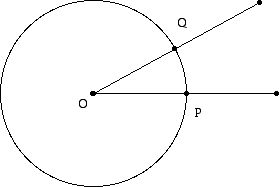Taxi!
Posted October 2007.
As we learn about the Taxicab Plane we learn to develop new intuitions about the phenomena that happen in the taxicab geometry world...
Joe Malkevitch
York College (CUNY)
malkevitch at york.cuny.edu 
Introduction
You have just arrived in town at the central railroad station and you are hoping to be able to make the 8 o'clock performance of the opera. The opera house is located at a point which, if we think of the railroad station as being at (0, 0), has coordinates (5, 12).
Is there any hope of your making the performance?
Traffic is so heavy in town you estimate you can actually walk as fast as a taxi can drive you there. How far is the opera house from the train station?
Since you are at (0, 0) and have to get to (5, 12), you fall back on your mathematical skills. You use your knowledge of Euclidean geometry and of the Pythagorean Theorem to see how far the opera house is from where you are located. You remember that in a right triangle, the sum of the squares on the two shorter sides equals the square on the longest side of the triangle. Thus, in general, if one has points with coordinates (x1, y1) and (x2, y2) the helicopter (Euclidean distance) is given by:
The opera house's distance from the train station would be 13 units. However, unfortunately in an urban environment one can not typically get from one place to another the way a crow or helicopter can. The diagram shows a schematic for a piece of a typical urban center such as a part of Manhattan.
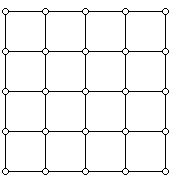 Figure 1 (A grid graph representing the layout of a piece of a street network of a city)
Figure 1 (A grid graph representing the layout of a piece of a street network of a city)To get from one corner to another, one has to move along the line segments shown in the diagram which are all assumed to have the same length 1. We can also introduce a coordinate system into this diagram by labeling the lower left hand dot with (0, 0) and the upper right hand dot would then have the coordinates (4,4), The distance in this situation, between (1,2) and (4,4), would be 5. Note, however, that the distance between (1/4, 0) and (7/8, 1) would not be (7/8-1/4) + (1-0) but the minimum of 1/8 + 1 + 3/4 and 7/8 + 1 + 1/4.
Sometimes the geometry that is hinted at in the calculations just made is called "urban geometry." Here the points of the geometry are points (x, y) where x and y lie on a line of the form x = u and y = v where u and v are integer constants, and the lines are x = u and y = v, and the distance between points generalizes the ideas in the examples above. (Can you write down what is required?)
What we will look at is much less realistic from an urban point of view but fascinating from the mathematical point of view. We use as our distance between a pair of points with coordinates (x1, y1) and (x2, y2) the taxicab distance function, which is given by:
The name of this distance function is suggestive of the fact that in Figure 1 the distance between (1, 2) and (4, 4) is 5 and not  , as a crow would fly, because a taxi would have to follow the grid lines. Notice that the geometry here uses all ordered pairs (x, y) where x and y can be any real numbers. For an urban setting this is not really the proper distance function.
, as a crow would fly, because a taxi would have to follow the grid lines. Notice that the geometry here uses all ordered pairs (x, y) where x and y can be any real numbers. For an urban setting this is not really the proper distance function.
The geometry implicit here has come to be called Taxicab Geometry or the Taxicab Plane. The points of this plane are (x, y) where x and y are real numbers and the lines of the geometry are the same as those of Euclidean geometry: Thus, the lines of the Taxicab Plane are point sets which satisfy the equations of the form Ax + By + C = 0 where both A and B are not 0. Again, note that although taxicab geometry is not as "realistic" as "urban geometry," when restricted to a point with integer coordinates, it will give the same distances. To get from the railroad station to the opera house, the taxicab distance would be 17. Walking distance would also be 17. The cost of a taxi ride between the railroad station and the opera would depend on the number 17 more than on the number 13 (the Euclidean distance we figured earlier).
Axiomatics
How does the axiomatic system of the Taxicab Plane differ from that of the Euclidean plane? Let us briefly recall the axiomatic point of view. Perhaps the following analogy will be helpful.
Think about the "American national game" - baseball. Even people only vaguely acquainted with the game know that baseball involves 9 innings of play, that 3 strikes make an "out" and that 4 "balls" give rise to a walk. Let us indicate these "parameters" or numerical features of baseball by the triple (3, 4, 9). Ordinary baseball can be thought of as (3, 4, 9) baseball. Now imagine that we decide to change the rules of ordinary baseball: we propose to keep all the usual rules of the game except that we will have only 2 strikes for an out. Thus, this new baseball would be described by (2, 4, 9) baseball. This game is NOT baseball as we know it, but it is closely related to baseball.
Here are some questions about this new game that you can try to answer based on your knowledge of ordinary baseball.
a. Will a typical game of (2, 4, 9) baseball last more time or less time than a typical game of (3, 4, 9) baseball?
b. Will a typical game of (2, 4, 9) baseball have a higher or lower score than a typical game of (3, 4, 9) baseball?
c. Will batters or pitchers be happier with (2, 4, 9) baseball than with (3, 4, 9) baseball?
Almost certainly you can use your knowledge about ordinary baseball to help you reach some conclusions about the nature of the baseball-like game (2, 4, 9) baseball.
Working with axiom systems in geometry is very much like analyzing what will happen to a game when its rules are changed.
Euclidean geometry as presented by Euclid was one of the great triumphs of human intellectual history. Euclid's work is presented in his extraordinary Elements, which consists of thirteen books. However, given that Euclid began his compendium of geometry over 2000 years ago, it is not surprising that he did not get it all quite right, as impressive as the Elements are.
Euclid thought that it was possible to give meaning to all of the terms that he used in his deductive system. Perhaps this is because he felt that his work was an attempt to describe the physical points and lines that he saw in the world around him. Lines were very thin straight roads and points were very small, indivisible dots. Perhaps for him in creating his Elements he was studying physics but from the perspective of the geometry of our world. However, from a modern perspective we realize that it is impossible to use language to give meaning to all other words. For the plane version of Euclidean geometry the words we take as undefined are "point" and "line." (There are other systems that turn out to be "equivalent" to Euclidean geometry that use other undefined terms from these or work at capturing the foundation of geometry from a different perspective. I will not try to deal here with these issues, as fascinating and intriguing as they are. In addition, one needs "rules" or "axioms" that involve these undefined terms.) Euclid originally used 5 "geometrical" rules or "postulates." Using the famous translation from the Greek due to T.L. Heath these are stated:
1. To draw a straight line from any point to any point.
2. To produce a finite line continuously in a straight line.
3. To describe a circle with any centre and distance.
4. That all right angles are equal to one another.
5. That, if a straight line falling on two straight lines make the interior angles on the same side less than two right angles, the two straight lines, if produced indefinitely, meet on that side on which are the angles less than the two right angles.
(Photo of T.L. Heath)
A modern "equivalent" (though the mathematician C.L. Dodgson (Lewis Carroll) argued that Euclid's version is better), when taken together with other axioms for the last postulate, can be stated:
If P is a point not on line m, then there is a unique line n parallel to line m that P lies on.
The complex statement of the Fifth Postulate (axiom) of Euclid led to many attempts to show that it could be logically deduced from the other geometric rules that Euclid gave. An axiom which can not be proved from the other axioms in a system is called independent of the others. However, in the 19th century the work of Bolyai and Lobachevsky showed that Euclidean geometry was but one geometrical game among many. If other rules are substituted for the Fifth Postulate, one gets other fascinating geometries. It was the work of the great 20th century geometer David Hilbert that provided a rigorous modern axiomatic treatment of Euclidean geometry, though, in fact, additional footnotes and ideas related to his work continue to be developed to this day.The axioms that Hilbert developed are all independent of each other. Many interesting examples of geometries arise from taking all the Hilbert axioms except one, say axiom A, and showing that there is a geometry in which all the Hilbert axioms (other than A) and a negation of A hold.
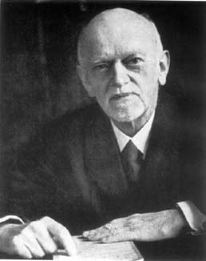 (Photo of David Hilbert)
(Photo of David Hilbert)
An example of an axiom which appears in Hilbert's compendium but not in Euclid is known as Pasch's Axiom:
If a line m cuts one side s of a triangle but does not pass through any of the three vertices of the triangle, then m has a point in common with a side of the triangle other than s.
Euclid is also not explicit about the issue of what today is known as congruence. Congruence involves the idea of when two things can be taken to be the same. When do two triangles have the property that one is the same as the other except for the fact that they are in different locations? Two segments are congruent when they have the same length. Intuitively, two triangles are congruent if they have two sides and the angle between these two sides match in size. When two triangles are congruent, we can superimpose one of the triangles on the other.
Amazingly, the Taxicab Plane satisfies all of the usual axioms (rules) of the Euclidean plane except one of the congruence axioms. Below is an example of two right triangles which have the same length legs but which are not congruent, or they do not appear to be if one adopts the definition of angle measure that is used between lines as being the measure used in Euclidean geometry.
We now know that the geometry defined by Hilbert's axioms for Euclidean geometry defines the same geometry as the "algebraic" approach to Euclidean geometry that was developed by Fermat and Descartes in what has come to be called analytical geometry. In this version of Euclidean geometry one thinks of the points as ordered pairs (x, y) where x and y are real numbers and the lines of the geometry are equations of the form ax + by = c where a, b, and c are real numbers and a and b are not both 0. A point (u, v) is on the line Ax + By + C = 0 if and only if Au + Bv + C = 0. As noted at the start, the only change in the analytical geometry framework to move to the Taxicab Plane is to change the distance function. (Strictly speaking, one also has to make a decision about angle measure. Here we will adopt the approach of using the same way to measure angles as is done in Euclidean geometry.)
One can see that the Taxicab Plane violates the congruence axiom by considering two of the triangles in Figure 2:
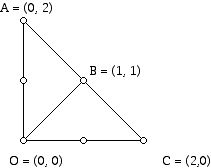 Figure 2 (Triangles in the Taxicab Plane can fail to obey the SAS (Side-Angle-Side) axiom of the Euclidean plane)
Figure 2 (Triangles in the Taxicab Plane can fail to obey the SAS (Side-Angle-Side) axiom of the Euclidean plane)
Triangle AOC is a right isosceles triangle with the two legs having length 2 and hypotenuse 4, while triangle OBC is also a right isosceles triangle with legs of length 2 but with hypotenuse 2. Weirdly, we have two triangles obeying SAS which are not congruent! In fact, triangle OBC is an equilateral triangle, but it is not equiangular, which is also "weird." The Taxicab Plane also violates SSS. Here is an example: the triangle with vertices (0,0), (1,3), and (3,1) has sides of length 4 as does the triangle with vertices (0,0), (0,4), and (2,2), but the second has a right angle and the first does not. This can be verified by checking the slopes of the lines making up the sides.
When one works in the Taxicab Plane, one has to build up new "intuitions" about the behavior of things that one has come to take for granted in Euclidean geometry. Just as the geometry on a sphere is very different from the geometry of the plane, the geometry of the number plane using the taxicab distance function is very different from the geometry of Euclid, based on the "pythagorean" distance function. In the discussion above we are assuming that we will measure angles in the Taxicab Plane the way that angles are measured in the Euclidean plane.
Adventures in the Taxicab Plane
Lines in the Taxicab Plane look like lines in the Euclidean plane, though the distances measured between points along lines can differ greatly from the Euclidean distances. What about circles? A circle is the set of point whose distance from a fixed point, the center of the circle, is a constant r, known as the radius of the circle. Using this definition, a circle is a "piece of wire" rather than a region.
The points centered about a fixed point, say (0,0) in the Euclidean plane whose distance is one from (0, 0), is our "friend" the "round" circle:
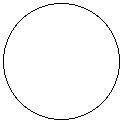 Figure 3 (The "round" circle of the Euclidean plane)
Figure 3 (The "round" circle of the Euclidean plane)The points centered around the point (0,0) (shown as a blue dot) in the Taxicab Plane which are distance 1 from (0,0) look very different! The circle is shown below, where the points at distance 1 are displayed in red.
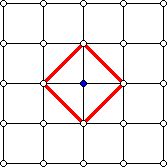 Figure 4 (A taxicab circle of radius 1, shown in red.)
Figure 4 (A taxicab circle of radius 1, shown in red.)To write down the number pairs that lie on the Euclidean circle we can use the simple equation:
Using equations to represent the taxicab unit circle centered at (0,0) without using the absolute value symbol can be accomplished by representing all four of the line segments that appear in Figure 4. However, we can also write:
Although it may seem strange to get used to the fact that one can measure the distance between points represented by ordered pairs of real numbers in different ways, and, hence, that there are different "circles" based on these different distance functions, there are, in fact, infinitely many different such circles. It was the Swiss-born mathematician Hermann Minkowski who realized this.
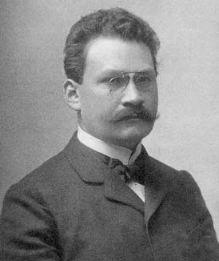 (Hermann Minkowski)
(Hermann Minkowski)
Minkowski showed that every centrally symmetric convex set about (0, 0) could serve the role of a unit circle with respect to a suitable distance function! What is meant by distance function is a scheme that assigns to pairs of points a number which is non-negative, is zero if and only if the points are the same, is symmetric (the distance from P to Q is the same as the distance from Q to P), and obeys the triangle inequality (the sum of the lengths of any two sides of a triangle is greater than the length of the third side).
Among the many advantages of studying the Taxicab Plane is the value of seeing the way that familiarity conditions the way we think about phenomena. Sometimes the Taxicab Plane is more realistic for applications and in other cases it is the Euclidean plane that serves one's needs better. However, we have to be careful about what we take for granted, and the study of the Taxicab Plane dramatically shows this. The ways that we get of "looking at the world" based on the fact that the Euclidean plane is studied almost to the complete exclusion of other geometric worlds, result in our ingrained views set in place by one domain which will often not apply in other domains. For example, in the Euclidean world two circles with the same radius will either not have any points in common, have exactly one point in common, or have two points in common. In the taxicab geometry world the situation is VERY different. One can have circles that have no points in common, one point in common, two points in common, but also they can intersect in a whole segment of points!
One entertaining activity, once we learn about taxicab geometry, is to see what are the analogues in the Taxicab Plane of interesting problems or phenomena that occur in the Euclidean plane. For example, it is well known that given two points P and Q in the Euclidean plane, then the midpoint of this segment is a unique point. Furthermore, the locus of points equidistant from the two points P and Q is a line which bisects the segment PQ and which is perpendicular to this segment. Independent of the points P and Q the qualitative result is always the same - the set of points equidistant from two points is a straight line. However, the situation is dramatically different in the Taxicab Plane.
Consider the two points P = (-1, -1) and Q = (1, 1), shown as blue dots in Figure 5. What are the points equidistant from these two points? Clearly (0, 0), the midpoint of this segment, is equidistant from these two points, and there is a portion of a straight line, x + y = 0 all of whose points are equidistant from P and Q. However, there are many other points which are equidistant from P and Q. In fact, there are two "quadrants" of points equidistant from P and Q. In the diagram below the points P and Q are shown in blue and the points equidistant from P and Q are shown in red!
Figure 5 (The set of points in the Taxicab Plane equidistant from two points need not be a straight line.)
In fact, the situation is rather more subtle than even this example indicates. To get a better appreciation of what is involved, consider the following example. Suppose one needs to find the points in the Taxicab Plane that are equidistant from the points R= (0, 0) and S = (6, 2). These equidistant points have nothing to do with the perpendicular bisector of the segment RS. The points equidistant from R and S consist of two different rays in the vertical direction and a line segment of slope -1 that goes from the points (4, 0) to the point (2, 2)!
Figure 6 (Points equidistant from (0, 0) and (6, 2) in the Taxicab Plane.)
The points R and S in this example are endpoints of the diagonal of a rectangle which is wider than it is high. To practice that you understand what is going on here you might consider finding the points equidistant in the Taxicab Plane from (0, 0) and (6, 2), which are the endpoints of the diagonal shown in Figure 6. You can also think about what happens for points which would be the diagonal of a rectangle which is narrower than it is high. (For example, try finding the points that equidistant from (0, 0) and (2, 60). Finally, think about the case of those points that are equidistant from (1,0) and (0,1).) Although the analysis of these situations is not truly hard, there are a many different phenomena involved. In terms of what is going on one has to distinguish between the cases where the slopes of the lines between the points whose equidistance locus is being sought are ±1 and those in which the slopes are more or less than ±1 in value.
One issue that may have puzzled you in our discussion of the Taxicab Plane is the interplay between the concept of line and the concept of distance. In the Euclidean plane, the distance between (0, 0) and (4, 4) is  and in the Taxicab Plane the distance is 8. In the Euclidean plane there is only one "curve," that achieves the
and in the Taxicab Plane the distance is 8. In the Euclidean plane there is only one "curve," that achieves the  distance from (0, 0) to (4, 4) and this curve is the straight line between (0, 0) and (4, 4). However, in the Taxicab Plane there are many different ways to travel between these points that have a distance of 8. For example, one could go from (0, 0) to (0, 4) for a distance of 4, and then follow the segment (0, 4) to (4, 4) which will also have a length of 4, for a total of 8. Thus, there are many ways to get between (0, 0) and (4, 4) on a path of length 8. Perhaps it will surprise you that there are 70 different paths of length 8 from (0, 0) to (4, 4) in Figure 1 and, furthermore, there is an interesting connection between how many such paths there are from (0, 0) to (n, n) (in a larger grid graph than that shown in Figure 1) and the binomial coefficients.
distance from (0, 0) to (4, 4) and this curve is the straight line between (0, 0) and (4, 4). However, in the Taxicab Plane there are many different ways to travel between these points that have a distance of 8. For example, one could go from (0, 0) to (0, 4) for a distance of 4, and then follow the segment (0, 4) to (4, 4) which will also have a length of 4, for a total of 8. Thus, there are many ways to get between (0, 0) and (4, 4) on a path of length 8. Perhaps it will surprise you that there are 70 different paths of length 8 from (0, 0) to (4, 4) in Figure 1 and, furthermore, there is an interesting connection between how many such paths there are from (0, 0) to (n, n) (in a larger grid graph than that shown in Figure 1) and the binomial coefficients.
If we were able to travel to a planet in a far away star system, we would not be surprised to see exotic things. Even here on earth we can travel to places that look very exotic compared to the ones we knows on a regular basis. The Grand Canyon and Yellowstone Park are very different from Los Angeles or even a rural district of Kansas. Mathematical worlds are also built up by the experience we have with them. In Euclidean geometry we are used to round circles rather than the "polygonal" circles of the Taxicab Plane. As we learn about the Taxicab Plane we learn to develop new intuitions about the phenomena that happen in the taxicab geometry world.
A good example of having to adjust to a changed landscape between the Euclidean and Taxicab Planes is the idea of an equilateral triangle. In the Euclidean plane equilateral triangles have sides of equal length. Furthermore, it is easy to see that equilateral triangles in Euclidean geometry must also be equiangular, that is, they have three equal angles at their vertices.
Is it true that all equilateral triangles are equiangular in the Taxicab Plane? We already know that this is false from the example above (Figure 2) or from the additional example shown in Figure 7.
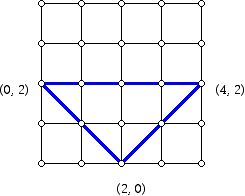 Figure 7 (Equilateral but not equiangular triangle in the Taxicab Plane.)
Figure 7 (Equilateral but not equiangular triangle in the Taxicab Plane.)
So far, we have said we were going to measure angles in the Taxicab Plane the way they are measured in the Euclidean plane. The situation is a bit subtle, actually. One can get different geometries by using other methods of measuring angles in the number plane endowed with the taxicab distance function. One such method is the analogue for the way radian measure is done in the Euclidean plane but using the taxicab unit circle to get at the measure of angles. It is amusing to note that the value of "pi" in the Taxicab Plane is not the same as for the Euclidean plane. If "pi" is taken to be the ratio of the perimeter of a taxicab circle to its diameter, then you should verify for yourself, using the taxicab circle in Figure 4, that the value of "pi" in the Taxicab Plane is 4. (Strictly speaking, you need to verify that the value you get is the same for all circles, not just the particular one in Figure 4, otherwise there would not be a "universal" value for "pi" in the Taxicab Plane.)
Another interesting aspect of the difference between the Euclidean plane and the Taxicab Plane concerns the coordinates of points which can be the vertices of equilateral triangles. In the Euclidean plane, is it possible for the three vertices of an equilateral triangle to all have integer (or even rational number) coordinates? It is not difficult to show that in the Euclidean plane this is not possible. However, in the Taxicab Plane there are some "strange looking" equilateral triangles, as we have seen. In particular, the triangle in Figure 7 has integer coordinates and equal side lengths. Can an equiangular triangle in the Taxicab Plane have vertices with integer coordinates?
While we are thinking of "weird" aspects of the Taxicab Plane, notice that in Figure 8 the lengths of OP and OQ in the Euclidean plane are the same.
Figure 8 (Rotating a segment in the Taxicab Plane with respect to Euclidean angle measure does not preserve taxicab lengths.)
However, the length of OQ in the Taxicab Plane is longer than that of OP. In the Taxicab Plane OQ is longer than OP. This means that our intuition about "symmetry" in Euclidean geometry can not be fully carried over to the Taxicab Plane. Translations preserve both Euclidean and taxicab distance; however, rotation does not always preserve taxicab distance. Doris Schattschneider has determined what the group of symmetries for the Taxicab Plane is with the Euclidean angle measure.
Praising via imitation
Many geometers and mathematicians have been attracted to study mathematics because early in their mathematical studies they were exposed to some of the very striking theorems of Euclidean geometry. Some of the most beautiful theorems of Euclidean geometry, beautiful because they display "coincidences" that are unexpected, involve when lines turn out to pass through a single point (are concurrent) or points turn out to lie on a single line (are collinear).
For example, given the triangle whose vertices are A, B, and C (where A, B, and C do not lie on a line) then:
* the perpendicular bisectors of the sides of the triangle are concurrent
* the perimeter bisectors for the triangle through the vertices of the triangle are concurrent
* the angle bisectors for the triangle's vertices are concurrent
* the altitudes of the triangle are concurrent.
(The altitude of a triangle is a line through a vertex which is perpendicular to the line which passes through the other two vertices of the triangle.)
Do these theorems remain valid in the Taxicab Plane?
Another approach to getting insights into both the Euclidean and Taxicab Planes involves taking a well known area of investigation in the Euclidean plane and trying to find the analogues of those ideas in the Taxicab Plane. We started an investigation of this kind above when we saw the differences between circles and the locus of points equidistant from two points in the Euclidean and Taxicab Planes.
Here are some examples that can be done in this spirit:
* What is the analogue of parabolas in the Taxicab Plane?
* What is the analogue of ellipses and hyperbolas in the Taxicab Plane?
(In the Euclidean plane there are two approaches to these ideas that coincide. One approach involves the sum or differences of distances between two fixed points and the other involves the idea of eccentricity. Do these two approaches lead to the same objects in the Taxicab Plane as well?)
* In the Euclidean plane, given three points not on a line, the triangle they determine has a unique circle that passes through the three points. Does this theorem hold in the Taxicab Plane?
* One of the most beautiful of the "coincidence" theorems of Euclidean geometry involves what is known as the nine point circle (sometimes also called the Euler circle). This theorem of Euclidean geometry states that for three points not on a straight line, the feet of the medians, the feet of the altitudes and midpoints of the segments between the orthocenter (where the altitudes meet) and the vertices all lie on a circle! Is there an analogue of this theorem for the Taxicab Plane?
A book which stimulated great interest in problems of this kind and the Taxicab Plane in general, was written by Eugene Krause. His book is a delightfully written gem.
Mathematics grows in many ways. Sometimes this involves proving a long-standing theorem from the past, sometimes it involves finding an application of long-established ideas, and sometimes it involves just having fun playing with the analogue between ideas in two different domains of the mathematical playground.
References
Brandley, M., Square circles, Pentagon, Fall, 1970, p. 8-15.
Brisbin, R. and P. Artola, Taxicab trigonometry, Pi Mu Epsilon Journal, 8 (1985) 89-95.
Byrkit, R., Taxicab geometry - A Non-Euclidean geometry of lattice points, Math. Teacher, 64 (1971) 418-422.
Dawson, R., Crackpot angle bisectors!, Mathematics Magazine, 80 (2007) 59-64.
Dekster, B., An angle in Minkowski space, J. of Geometry, 80 (2004) 31-37.
Gardner, M., The Last Recreations, Springer-Verlag, 1997.
Golland, L., Karl Menger and taxicab geometry, Mathematics Magazine, 63 (1990) 326-327.
Heath, T., The Thirteen Books of Euclid's Elements, Dover Publications, New York! , 1956.
Iny, D., Taxicab geometry: another look at conic sect ions, Pi Mu Epsilon Journal, 7 (1984) 645-647.
Kennedy, H., The origins of modern axiomatics: Pasch to Peano, Amer. Math. Monthly, 79 (1972), 133-136.
Krause, E., Taxicab Geometry, Dover, New York, 1986.
Laatsch, R., Pyramidal sections in taxicab geometry, Math. Magazine, 55 (1982) 205-212.
Mertens, L., A fourth dimensional look into taxicab geometry, J. of Undergraduate Mathematics, 19 (1987) 29-33.
Moser, J. and F. Kramer, Lines and parabolas in taxicab geometry, Pi Mu Epsilon Journal, 7 (1982) 441-448.
Reynolds, B., Taxicab geometry, Pi Mu Epsilon Journal, 7 (1980) 77-88.
Schattschneider, D., The taxicab group, Amer. Math. Monthly, 91 (1984 423-428.
Sheid, F., Square circles, Math. Teacher 54 (1961) 307-312.
Sowell, K., Taxicab geometry - A new slant, Mathematics Magazine, 62 (1989) 238-248.
Thompson, K. and T. Dray, Taxicab angles and trigonometry, Pi Mu Epsilon Journal, 11 (200) 87! -96.
Joe Malkevitch
York College (CUNY)
malkevitch at york.cuny.edu 
Those who can access JSTOR can find some of the papers mentioned above there. For those with access, the American Mathematical Society's MathSciNet can be used to get additional bibliographic information and reviews of some these materials. Some of the items above can be accessed via the ACM Portal , which also provides bibliographic services.









 , as a crow would fly, because a taxi would have to follow the grid lines. Notice that the geometry here uses all ordered pairs (x, y) where x and y can be any real numbers. For an urban setting this is not really the proper distance function.
, as a crow would fly, because a taxi would have to follow the grid lines. Notice that the geometry here uses all ordered pairs (x, y) where x and y can be any real numbers. For an urban setting this is not really the proper distance function.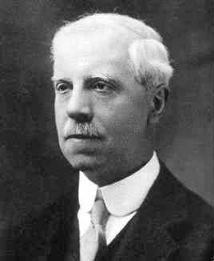







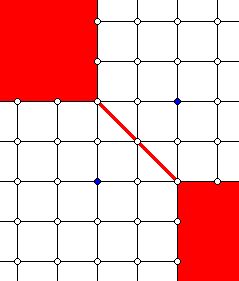
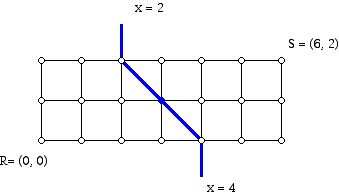
 and in the Taxicab Plane the distance is 8. In the Euclidean plane there is only one "curve," that achieves the
and in the Taxicab Plane the distance is 8. In the Euclidean plane there is only one "curve," that achieves the  distance from (0, 0) to (4, 4) and this curve is the straight line between (0, 0) and (4, 4). However, in the Taxicab Plane there are many different ways to travel between these points that have a distance of 8. For example, one could go from (0, 0) to (0, 4) for a distance of 4, and then follow the segment (0, 4) to (4, 4) which will also have a length of 4, for a total of 8. Thus, there are many ways to get between (0, 0) and (4, 4) on a path of length 8. Perhaps it will surprise you that there are 70 different paths of length 8 from (0, 0) to (4, 4) in Figure 1 and, furthermore, there is an interesting
distance from (0, 0) to (4, 4) and this curve is the straight line between (0, 0) and (4, 4). However, in the Taxicab Plane there are many different ways to travel between these points that have a distance of 8. For example, one could go from (0, 0) to (0, 4) for a distance of 4, and then follow the segment (0, 4) to (4, 4) which will also have a length of 4, for a total of 8. Thus, there are many ways to get between (0, 0) and (4, 4) on a path of length 8. Perhaps it will surprise you that there are 70 different paths of length 8 from (0, 0) to (4, 4) in Figure 1 and, furthermore, there is an interesting 
